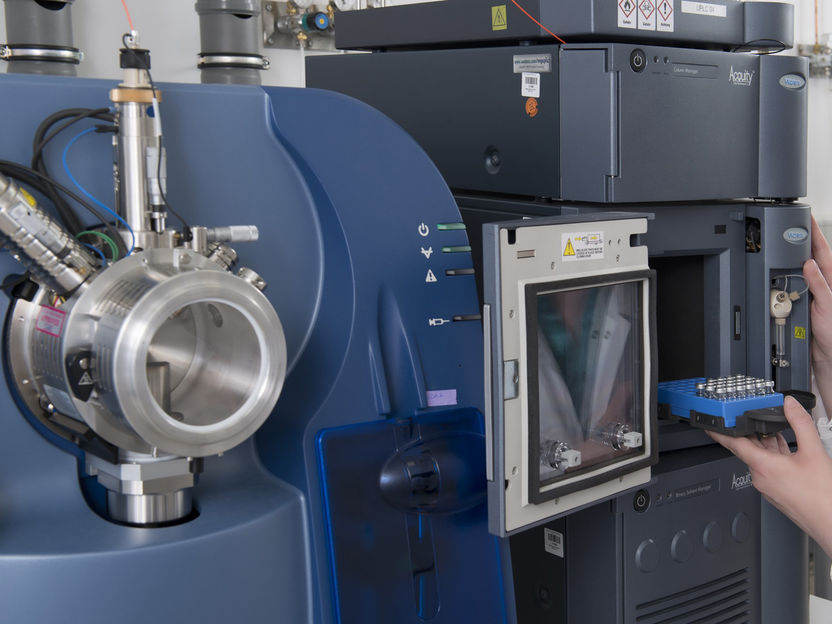BASF to research on alternatives to animal testing on behalf of the European Chemicals Agency
Number of animal experiments required for safety assessments of chemical substances to be further reduced
The European Chemicals Agency (ECHA) has contracted a consortium that includes BASF to conduct scientific studies on the reliability and relevance of New Approach Methodologies (NAMs) as alternatives to animal testing and to promote the use of such methods in the future. The aim of the contract is to get additional NAMs accepted by regulatory authorities, focusing on molecular biological technologies (OMICS and toxicokinetics), and thereby further reduce the number of animal studies conducted as part of safety assessments for chemical substances. The contract will run for six years and has a total value of €4.2 million in ECHA funding.

Analytical Instrument for assessment of metabolomic changes The European Chemicals Agency (ECHA) has contracted a consortium that includes BASF to conduct scientific studies on the reliability and relevance of New Approach Methodologies (NAMs) as alternatives to animal testing and to promote the use of such methods in the future.
BASF SE
The contract research project is led by the Fraunhofer Institute for Toxicology and Experimental Medicine (ITEM) in Hanover, Germany. ITEM, Michabo Health Science, based in Coventry, England, and BASF Metabolome Solutions in Berlin, Germany, are coordinating the work. Other partners include the department for experimental toxicology and ecology at BASF in Ludwigshafen, Germany, the University of Birmingham in England and the biotech companies BioClavis, based in Glasgow, Scotland, and Novogene Europe, based in Cambridge, England.
The research partners will support ECHA in developing guidelines that can be used to reliably predict the properties of substances for which there is not yet sufficient safety information. The grouping and read-across approach uses existing safety data from structurally similar substances to make these predictions. “This approach is already being used to close data gaps in registrations under the EU chemicals regulation REACH. We would like to expand it further, for example, through the use of molecular biological methods. If grouping and read-across is correctly applied, there is no longer a need to test every substance on animals. We will therefore be able to further reduce the number of animal studies and the costs for safety assessments,” said the toxicologist Professor Hennicke Kamp, Managing Director at BASF Metabolome Solutions.
A major focus of the research is evaluating the informative value of OMICS technologies in chemical safety assessments. These technologies can be used to study, among other things, the activation of genes (transcriptomics) or entire metabolic processes (metabolomics) in cultured cells or a living organism. With OMICS technologies, researchers can measure numerous different changes in a biological sample to extrapolate whether substances have a potentially hazardous effect. Transcriptomics can, for example, determine how the activities of genes change after exposure to a certain substance. The researchers can then draw conclusions about changes to cells or organs. Metabolomics technologies can be used to study metabolic products in cells, such as amino acids, lipids or hormones. If these change, the health of an organism can be evaluated, much like a diagnostic blood test at the doctor’s office.
The research team aims to find out under which conditions the OMICS technologies can reliably deliver relevant and reproducible findings for assessing the safety of chemical substances. Regulatory authorities should then be able to consult these findings when assessing the substances. This could also further reduce the number of animal studies needed in the future. The necessary regulatory guidelines also have to be developed.
The project will also evaluate methods to predict the toxicokinetic behavior of substances in an organism, including how they are absorbed, distributed and excreted, as well as to evaluate the accumulation and degradation of substances. These methods comprise computational modeling approaches, so-called physiologically based kinetic (PBK) models. To facilitate the application and implementation of such PBK modelling data in regulatory toxicology, the consortium will evaluate the applicability of PBK models and their input parameters, in particular the in silico (in computers) and in vitro (experiments on cells, tissue or organs and isolated under controlled conditions outside the body) toxicokinetic parameters. A special focus is to better understand the performance and limitations of these methods, the current knowledge and data gaps.































































